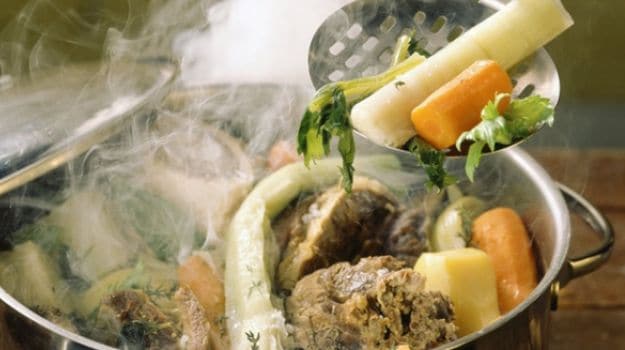Gone are the days when a lack of central heating and a fear of salmonella meant food had to be served at thermonuclear temperatures. But does that superheat enhance flavour and appetite, or merely leave your soft palate raw and wounded?Like many of you, I suspect, I am regularly nursing a wounded mouth. The roof of it and sometimes the gums and insides of my cheeks are, on a monthly basis, subject to abrasions, blisters and the attendant sore flaps of skin. There have even been occasional painful lip injuries, too. Why is this happening? Because – and it feels liberating to finally say this out loud – I live with a Heater.
A Heater is someone who, regardless of how many times you burn your mouth on their food, is incapable of serving it at anything less than thermonuclear temperatures. Plates are heated, habitually. Food must always be dished up straight from the oven or stove. Despite the fact that it may still be bubbling with violent heat, swirling with molten cheese or unleashing warning gusts of steam, if you do not claim your plate within 45 seconds, said meal will be returned to the oven, “to keep it warm”. If there were a practical way of superheating the cutlery (who wouldn’t want to eat wearing oven gloves?), the Heater would surely do it.
This is why, quite often, when I sit down to eat, the first thing I say is not, “This is nice,” but, after a split second of yelping and hurriedly spitting food back on to my plate: “Christ almighty, what the [expletives deleted] have you DONE to this? How do you even [further expletives deleted] make food that hot?” There are tears (mine) and, from the Heater, blank incomprehension – as if it is normal to serve food you can only approach in specialist fire-retardant clothing.
You may have thought that such heat-insensitive delivery was fading fast from British life. A demand that food be served “piping hot” is seen as the preserve of an older generation who grew up without central heating and a (by now, exaggerated) fear of falling ill due to undercooked food. To them, a boiling-hot stew was a safe stew. But, clearly, this tradition persists in Heaters who, in other ways, are highly capable cooks and who have eaten widely enough to know much better.
The noughties had foodies questioning the whole concept of what hot, cooked food is. Ferran Adrià’s popularisation of dining as an exploration of “flavour, temperature and texture”, often led to widely contrasting temperatures on the plate, in the form of gels, jellies, foams and snows. Thanks to the rise of sous-vide and other highly accurate low-temperature cooking techniques, we came to accept that the main protein element of a dish would often arrive thoroughly cooked, but only warm. Not hot. That idea – that turning down the temperature could hugely intensify flavour – was revelatory and it has reverberated in other spheres, too. For instance, a good flat white should be served at an immediately drinkable temperature, as many coffee drinkers now accept.
Insomuch as science has investigated it, there is some evidence that if food is served at higher temperatures, the heat inhibits flavour. Of course, chilling or warming foods can restrain or encourage the activity of (un)pleasant, volatile flavour and aroma compounds. That is why we drink chilled white wine and, preferably, eat room-temperature tomatoes: to appreciate each at their fullest. But the idea that, after cooking a dish safely and having triggered the desired chemical changes in it, you can liberate more flavour by ramping up its temperature (or that it actually needs to be served hot) is wrong. As Karel Talavera Pérez, professor of molecular and cellular medicine at Belgium’s University of Leuven, previously told the Guardian, when eating foods with a temperature of 35C or more, our perception of taste decreases. Any burning sensations may even shut down flavour-signalling to the brain, as a safety mechanism.
I have another pet theory, too: that the process of steaming blocks or dilutes flavour. If you have ever cooked a sponge pudding in a microwave (a process of heating that works primarily by agitating water molecules), you will know what I mean. The pudding comes out – literally steaming – and, for several minutes while water continues to energetically evaporate from it, you cannot really taste anything. It is as if the water is condensing as it hits your nose and tongue, masking any flavour.
But will a Heater listen to any of this? No. They blithely turn up the oven, insisting that food should be served “wok hay”, as the Cantonese would put it (that is, with the searing heat of the wok sealed into the dish). It is up to you, the diner, to proceed with caution.
Do you agree? Does visibly steaming-hot food sharpen your sense of expectation and appetite? Or does it leave you fearing for your soft palate?






